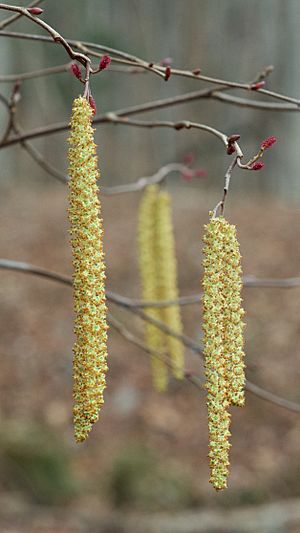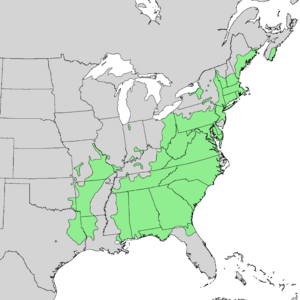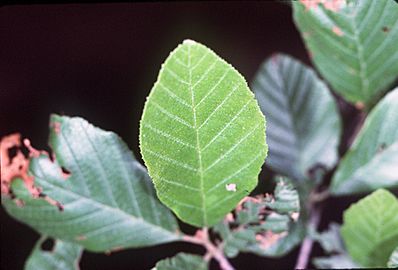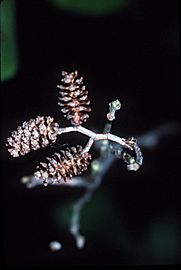Hazel alder facts for kids
Quick facts for kids Hazel alder |
|
|---|---|
 |
|
| Conservation status | |
| Scientific classification | |
| Genus: |
Alnus
|
| Species: |
serrulata
|
 |
|
| Natural range | |
Alnus serrulata, also known as the hazel alder or smooth alder, is a type of shrub that grows in thick groups. It belongs to the Betulaceae family, which includes birches. This plant is native to eastern North America. You can find it from western Nova Scotia and southern New Brunswick in Canada, all the way south to Florida and Texas in the United States.
Contents
About the Hazel Alder
The hazel alder is usually a large shrub or a small tree. It can grow up to 2.5 to 4 meters (about 8 to 13 feet) tall. Its scientific name, Alnus serrulata, comes from "alnus," an old name for alder. "Serrulata" means "finely-toothed," which describes the edges of its leaves. This plant takes about 10 years to grow to its full size. It likes wet soil, often found near streams, ponds, and rivers. It usually has many stems growing from its base.
Leaves
The leaves of the hazel alder are simple and round. They are about 5 to 13 centimeters (2 to 5 inches) long. They are wider in the middle and have a V-shape at their base. The top side of the leaves is dark green and smooth. The underside is pale green and feels a bit hairy.
Flowers and Reproduction
The hazel alder has both male and female flowers on the same plant. This is called being monoecious. The male flowers, called catkins, are long and hang down. The female flowers are smaller and cone-like. These reddish-green flowers usually open in March or April.
Fruit
After flowering, the plant produces a dark brown, cone-like fruit. This fruit is hard and has scales. Inside, there are small seeds. These seeds do not have wings. The fruit usually ripens in the fall and stays on the plant for a long time.
Twigs and Bark
The young branches, called twigs, are reddish-brown. They are often covered with tiny hairs. The bark of the hazel alder is brownish-gray and smooth. It has a slightly bitter taste.
Where it Grows
The hazel alder is mostly found in eastern North America. Its range stretches from Maine down to northern Florida. It also grows west into parts of Oklahoma, Missouri, and Illinois. You can often see it growing along the Mississippi River. However, it is not found in northern New Hampshire and Vermont. This plant is often found in wetlands. It is considered a "facultative wetland species" in some areas, meaning it often grows in wetlands but can also grow in drier places. In other regions, it is an "obligate wetland species," meaning it almost always grows in wetlands.
Plant Names
The scientific name for this plant is Alnus serrulata. It has several common English names, including common alder, tag alder, hazel alder, and smooth alder.
Growing Conditions
You can find the hazel alder in many wet places. These include streambanks, riversides, and swamps. It needs a lot of water and prefers sunny or partly sunny spots. The soil it grows in should be moist. It also prefers soil that is slightly acidic to neutral. If you were planting them for wildlife, you would space them about 1.5 to 3 meters (5 to 10 feet) apart.
Uses of Hazel Alder
Because the hazel alder often grows along rivers and streams, it helps to stabilize the soil. This prevents erosion and helps restore these natural habitats. People have also used parts of the plant for different purposes. For example, a tea made from its bark was sometimes used to help with things like diarrhea, coughs, and toothaches.





